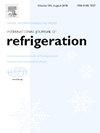不同形线几何参数下喷射器性能的数值分析
IF 3.5
2区 工程技术
Q1 ENGINEERING, MECHANICAL
International Journal of Refrigeration-revue Internationale Du Froid
Pub Date : 2025-07-08
DOI:10.1016/j.ijrefrig.2025.06.028
引用次数: 0
摘要
在喷射器制冷系统(ERS)中,喷射器的夹带比直接取决于一次流体(发生器)和二次流体(蒸发器)之间的混合。在此分析中,我们研究了固定数量的N时,v形尖端角β的变化对夹带比的影响。通过求解以水蒸气为工质的可压缩和湍流方程以及旋转周期边界条件,在稳态下进行了分析。刀尖角为60°时剪切层厚度较高,且下游较为保守,夹带比最高,为0.4705。二次流体流动角的变化是影响夹带比增加的重要参数。此外,在给定的工作和几何条件下,对于所有数量的线形,最佳L/D%在68%±5%的范围内。随着侵彻角α的变化,夹带比没有变化。本文章由计算机程序翻译,如有差异,请以英文原文为准。
Numerical analysis on ejector performance with varying geometric parameters of chevrons
The entrainment ratio of the ejector in an ejector refrigeration system (ERS) directly depends on the mixing between the primary fluid (generator) and the secondary fluid (evaporator). In this analysis, the effect of variation of chevron tip angle for a fixed number of chevrons N on the entrainment ratio has been studied. The analysis has been conducted in a steady state by solving the compressible and turbulence equations and rotational periodic boundary conditions with water vapor as the working fluid. The shear layer thickness for the chevron tip angle 60° is not only higher but also conserved downstream, resulting in the highest entrainment ratio of 0.4705. The variation of secondary fluid flow angle for different chevron tip angles is a significant parameter for the increment in the entrainment ratio. Also, the optimum L/D for the given working and geometry conditions lies within the range of 68% for all numbers of chevrons. There has been no improvement in the entrainment ratio with the variation in the penetration angle .
求助全文
通过发布文献求助,成功后即可免费获取论文全文。
去求助
来源期刊
CiteScore
7.30
自引率
12.80%
发文量
363
审稿时长
3.7 months
期刊介绍:
The International Journal of Refrigeration is published for the International Institute of Refrigeration (IIR) by Elsevier. It is essential reading for all those wishing to keep abreast of research and industrial news in refrigeration, air conditioning and associated fields. This is particularly important in these times of rapid introduction of alternative refrigerants and the emergence of new technology. The journal has published special issues on alternative refrigerants and novel topics in the field of boiling, condensation, heat pumps, food refrigeration, carbon dioxide, ammonia, hydrocarbons, magnetic refrigeration at room temperature, sorptive cooling, phase change materials and slurries, ejector technology, compressors, and solar cooling.
As well as original research papers the International Journal of Refrigeration also includes review articles, papers presented at IIR conferences, short reports and letters describing preliminary results and experimental details, and letters to the Editor on recent areas of discussion and controversy. Other features include forthcoming events, conference reports and book reviews.
Papers are published in either English or French with the IIR news section in both languages.

 求助内容:
求助内容: 应助结果提醒方式:
应助结果提醒方式:


